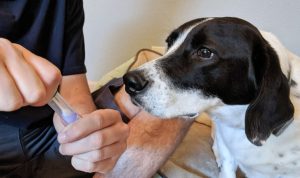Identifying a what breed is my dog can be an important step in understanding its behavior and habits. It is also beneficial in determining what type of medical care may be required or necessary to keep your pet healthy.
This article will discuss several different methods for determining a dog’s breed, including observing physical characteristics, exploring breed standards, utilizing DNA tests, consulting with a professional, and investigating your pet’s history.
By using these methods, you can determine your dog’s breed with greater accuracy and confidence.

Whether your dog is a rescue or purebred animal, it is still essential to understand its background. This knowledge can help you make informed decisions regarding your pet’s healthcare needs, nutrition requirements, and overall quality of life.
In addition to personal satisfaction from knowing the answer to “What breed is my dog?” many practical benefits come from correctly identifying the breed.
These include ensuring appropriate veterinary care and providing training tailored specifically to the needs of that particular breed.
Observing Physical Characteristics
Physical characteristics are important to consider when identifying the type of canine in question. Different breeds have different proportions of their bodies and unique markings, which can help determine the species.
Examine the coat type and color, as certain breeds tend to have a particular style and color of fur. Additionally, analyze the shape and size of the build, as this can be an important indicator for some breeds over others.
The size and shape of the muzzle are also significant when determining what kind of dog one has; certain species have longer snouts, while others have shorter ones. Fur length is another clue that can hint at a dog’s breed; short-haired dogs often appear differently than those with long coats.

The ears are another body part that should be noticed when identifying a canine’s breed; some will feature large pointed ears, while others might be floppy or cropped short. Furthermore, look at how far apart or close together the eyes are set on either side of its head, as this could also indicate specific breeds.
Analyzing eye color is also useful in distinguishing between possible species; some dogs’ eyes will be darker shades, whereas others will have lighter hues, such as blue or yellowish-brown tones, depending on their genetics.
In addition to physical characteristics, other factors need to be considered, such as behavioral traits and health records, if available from previous owners – these can all play a role in helping you decide what breed your pup belongs to.
Please pay attention to its activity level as well because certain pooches require more exercise than others due to their energy levels being higher than average; for example, sighthounds like Greyhounds tend to need more time outdoors running around compared with, say, Bulldog types who prefer lounging about indoors, most days!
Conducting research online via reputable sources is recommended since it offers access to detailed information regarding individual canine species that would otherwise take much longer to find out through other means – even pet stores may not always know the exact background details, so double checking with reliable resources before making any decisions is strongly advised!
Exploring What Breed Is My Dog Standards
Investigating the characteristics of particular canine varieties can be informative and fascinating. Exploring breed standards can be useful for dog owners seeking to understand what breed their pup is.
Breed standards are detailed descriptions that typically cover topics such as:
- Physical attributes: This information will include details about height, weight, coloring, coat length, and texture.
- Temperament: The personality traits associated with a specific breed might be discussed in its standard.
- Health issues: Some breeds have known genetic health issues or predispositions for certain medical conditions that should be considered when researching a particular variety of dogs.
Studying the work of experienced breeders and evaluating genetics can provide valuable insight into the heritage of an animal.
Different countries may have different standards for other breeds, which provides an interesting contrast between regions and offers clues about the origins of one’s pet.
Investigating various kennel clubs can also yield helpful information regarding canine varieties; some may even provide DNA testing services to help determine more precise lineage information from parentage testing to whole-genome sequencing.

By learning more about the individual qualities associated with different breeds and examining inherited traits, one can learn about one’s pup while appreciating the unique combination of characteristics that make them special and beloved companions.
Understanding where our furry friends come from can deepen our bond with them – providing us with invaluable insight into their behavior, needs, and personalities so we can better care for them throughout their lives.
Utilizing DNA Tests
Utilizing DNA tests to understand further a canine’s lineage can provide invaluable information about its individual qualities and inherited traits. One can gain insight into a dog’s breed by analyzing behavior, researching ancestry, and utilizing DNA testing.
For example, a mixed-breed dog may have genetic markers from several different breeds that enable them to exhibit certain behaviors or physical characteristics. Using a DNA test, one can determine what breed is dominant and which other breeds contribute to the overall makeup of the dog in question.
DNA testing for dogs has come a long way since its initial conception. Tests are available that provide detailed and accurate results with minimal effort from the owner or pet caretaker.

The sample required for most tests is typically saliva or blood taken from the dog itself; however, some tests utilize hair follicles or cheek swabs, depending on the analysis. Once collected, samples are sent to laboratories where they are analyzed using advanced technology such as polymerase chain reaction (PCR). Results typically take 2-4 weeks before being returned to those who requested them.
The amount of information these tests yield varies based on certain factors, like how much data was inputted by researchers into databases used by labs conducting these types of analyses.
Generally speaking, some common results include gender determination and percentage breakdowns regarding particular breeds found within a given sample. Additionally, some companies offer additional services, such as providing general health assessments and other related insights based on certain genetic markers identified in the model provided.
By understanding its genetic makeup, it becomes easier to identify specific conditions that may be inherited by a particular breed as well as potential predispositions towards certain illnesses or diseases; this allows owners and pet caretakers alike to make informed decisions when it comes to selecting proper treatments plans for their animal companions if needed down the road.
Utilizing DNA testing provides owners with peace of mind knowing exactly what kind of animal they have welcomed into their home while simultaneously enabling them with valuable knowledge about any potential medical issues associated with said animal’s genetics moving forward.
Consulting with a Professional
Consulting with a professional specializing in a canine lineage can provide invaluable insight into potential inherited traits and characteristics of one’s canine companion, offering guidance like a beacon at night.
Understanding breeders and analyzing families is key to determining the true genetic makeup of one’s pup. A qualified specialist can offer support from the initial inquiry through follow-up consultations, utilizing their expertise to guarantee accurate results.
In some cases, visiting a trusted breeder may benefit those looking for more clarity on the type of dog they have. Speaking with an experienced expert in person gives owners access to valuable information regarding their pup’s heritage and any potential health complications that may arise due to inherited illness or other factors.

Furthermore, often specialize in specific breeds and possess extensive knowledge about certain types of dogs that could prove useful for pet parents seeking additional details about their furry family members.
It is important to note that further research should always be conducted before making any decisions based on the opinion of a single source, such as a breeder or specialist. Consulting multiple sources will help create an overall picture that offers greater detail while ensuring accuracy regarding one’s four-legged friend’s ancestry and genetics.
Additionally, accessing online resources and reading up on different can provide helpful context when answering questions related to ‘What breed is my dog?’.
Overall, consulting with experts who are knowledgeable about canine genetics can be extremely beneficial when it comes to discovering more information about one’s pup and its unique characteristics; however, researching across multiple platforms will ensure accuracy when verifying results provided by professionals and uncovering the true identity behind man’s best friend.
Investigating Dog’s History
By exploring available resources, owners can better understand their canine companion’s history and potential inherited traits.
Examining adoption records or researching rescue organizations may provide information about the dog’s breed makeup.
Additionally, speaking with previous owners and observing physical characteristics may help identify the combination of species in a mixed-breed animal.
DNA testing is another way to learn more about a pet’s history. These tests can reveal ancestry information for thousands of breeds worldwide and are relatively easy for pet parents to purchase and administer at home.
With knowledge of genetic heritage, owners are better equipped to understand possible health risks associated with specific breeds and any potential temperament issues that could arise from certain species combinations.

A third option is to consult an experienced professional such as a veterinarian or a certified animal behaviorist, who can provide insight into your pet’s history and personality based on their experience with similar animals.
While this approach requires an upfront cost, it is invaluable in helping you make informed decisions regarding caring for your four-legged friend.
Finally, while all these tools are useful in learning more about your pup’s background, they should be used with plenty of love and patience during training sessions so that both owner and dog can create lasting memories together.
Frequently Asked Questions
How do I know which breed is best for me?
When choosing the right breed for you, it is important to consider your lifestyle and exercise needs.
As well as their socialization habits, which may determine whether or not they are suitable for family life.
Researching various breeds can be daunting, but one that pays off in the end.
You should consider the space you have in your home and yard, how much time you have to dedicate to caring for your pet, and any health concerns associated with particular.
With careful consideration, you can find the perfect fit for your life – a furry companion whose loyalty and unconditional love will bring joy to you every day.
How do I choose a good breeder?
Choosing a reputable breeder is important in finding the right dog for you.
Dog shows and breed standards provide a good starting point to help determine if a breeder is trustworthy.
Reputable breeders should strive to produce healthy puppies that meet the established standards for their chosen breed, as set forth by organizations such as The American Kennel Club (AKC).
They should also be open to questions about the parent dogs’ health and temperament and provide proof of pedigree and registration papers.
Additionally, visiting the kennel or home where puppies are bred before making any decisions is wise.
This will allow you to observe how the dogs are cared for and ask further questions about specific puppies.
Are there any health issues specific to certain breeds?
Prospective owners should consider the health issues specific to certain breeds when selecting a canine companion.
For instance, short-nosed breeds such as bulldogs and pugs are prone to breathing difficulties due to their flattened faces and shorter nasal passages.
Breeds with long backs, such as dachshunds and basset hounds, may be more likely to experience back problems due to their anatomy.
In addition, some breeds require more exercise than others, and grooming needs can also vary among breed types.
Knowing what health issues are associated with certain breeds can help pet owners make an informed decision when choosing a pup.
Are there any specific genetic traits to look for in a breed?
When considering a certain breed of dog, it is important to know the historical background and any existing genetic tests that have been conducted.
Genetic testing can determine if a specific breed has traits that may affect its health or behavior.
Additionally, knowledge of a breed’s history can provide insight into how the species has evolved genetically and what traits are associated with the particular breed.
By being aware of these genetic traits, owners can make better-informed decisions when choosing a pet.
How do I make sure I’m getting a purebred dog?
Acquiring a purebred dog requires considerable effort and research.
An integral step is researching pedigrees to ensure the desired breed and looking for reputable breeders that can provide evidence of health tests and certifications.
This is no small feat, as finding an ethical breeder who takes proper care of their animals is akin to searching for a needle in a haystack – it may seem impossible at times!
Nevertheless, with perseverance and dedication, one can find the perfect pup that fits their lifestyle and needs.
See Also:
- French Puppy Bulldog: Adorable, Affectionate, and Ready to Join Your Family
- Ultimate Guide to Puppy Yorkshire: All You Need to Know
- Boxer Lab Mix: A Complete Guide
Conclusion
The journey of determining a dog’s breed can be likened to a detective story, with each clue leading to the canine’s ancestry.
By observing physical characteristics, exploring breed standards, and utilizing DNA tests, one can begin to uncover their pup’s heritage.
However, if further investigation is needed, consulting a professional or researching your dog’s history may provide deeper insight into its background.
While identifying what breed your puppy is may take time and patience, it can be an enjoyable process that leads to a greater appreciation for its unique qualities.
Join the journey of compassion and rescue with bonevoyagedogrescue
